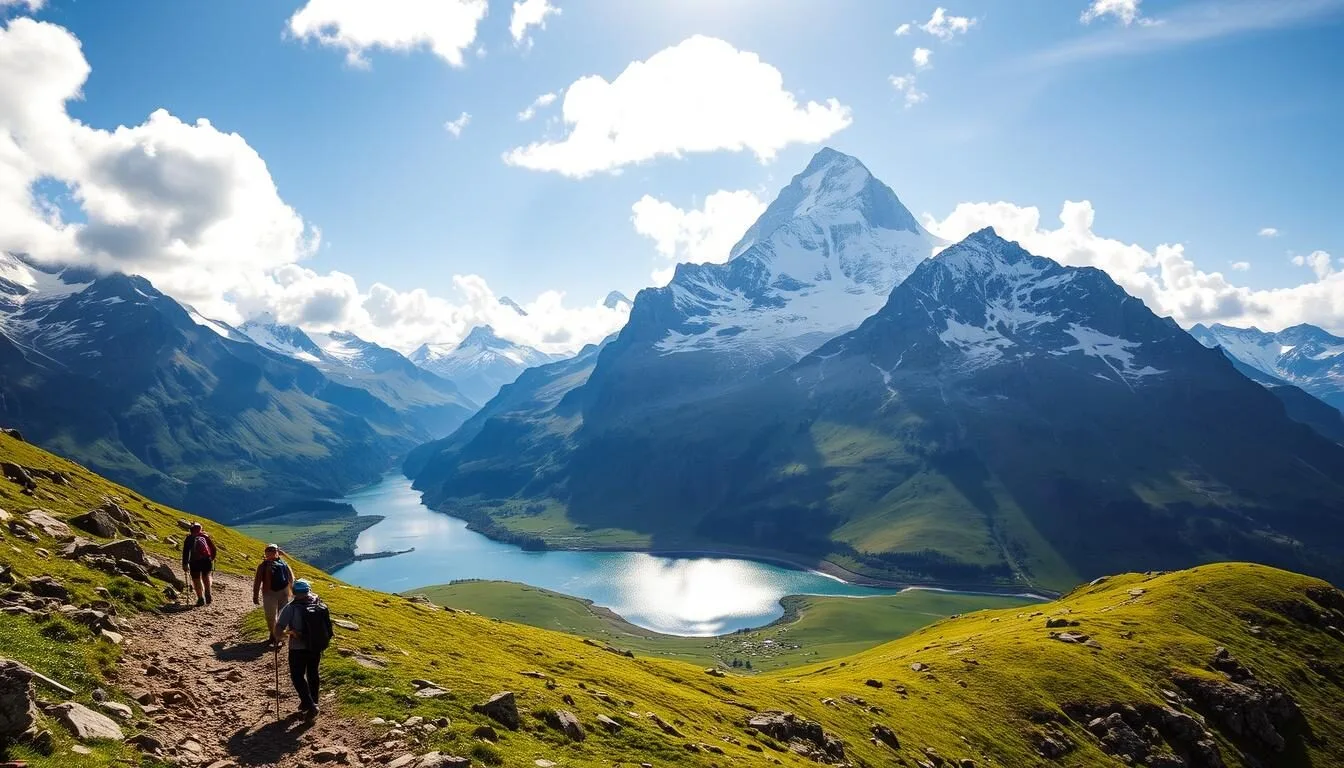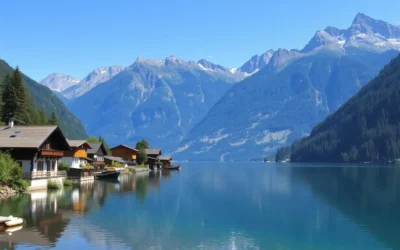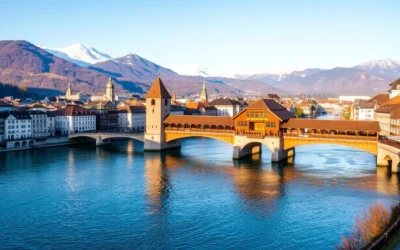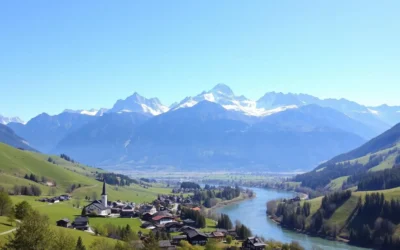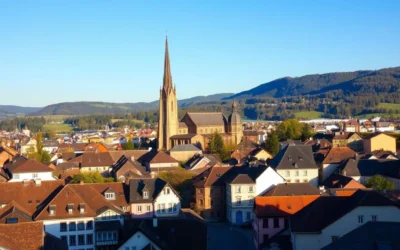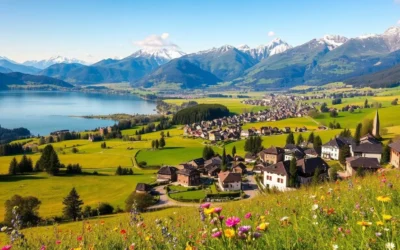Standing tall at 4,314 meters in the western Pennine Alps, the Grand Combin de Grafeneire is one of Switzerland’s most majestic yet underrated mountain destinations.
You are about to explore a comprehensive guide that will walk you through everything you need to know about visiting this Alpine giant.
From the Tour des Combins, a spectacular multi-day hiking circuit, to practical information on mountain huts, equipment needs, and transportation options, this guide has got you covered.
Whether you’re an experienced mountaineer or a hiker seeking breathtaking Alpine landscapes, you’ll learn how to make the most of your visit to this incredible mountain massif.
Discovering the Grand Combin Massif
As you venture into the Swiss Alps, the Grand Combin Massif stands out as a majestic destination. This mountain range offers a unique blend of natural beauty and adventure, making it an ideal spot for hikers and mountaineers alike.
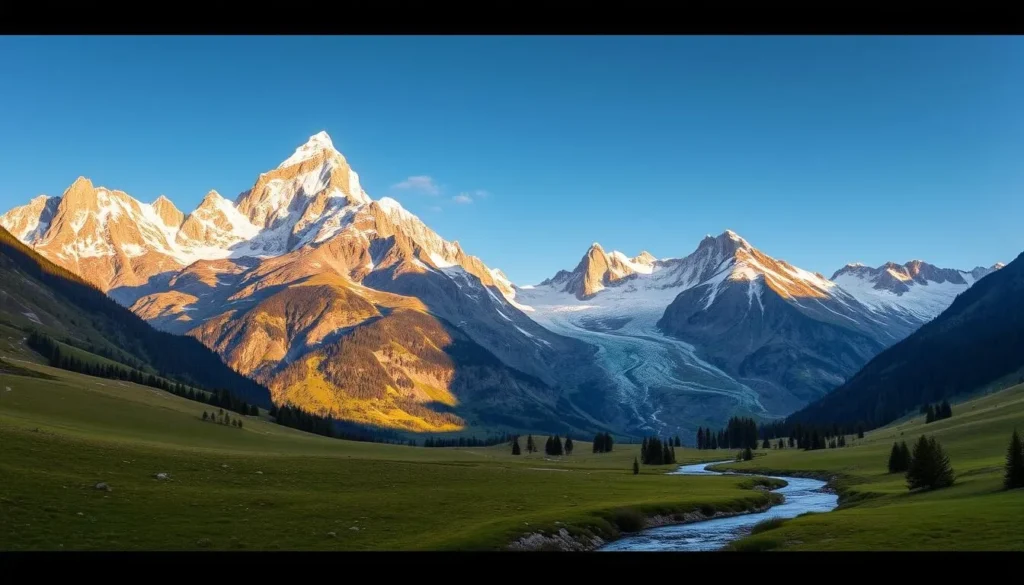
The Majestic 4,314-Meter Giant
The Grand Combin is a formidable mountain, with its highest peak, Combin de Grafeneire, reaching an elevation of 4,314 meters. This impressive height, while not as lofty as Mont Blanc’s 4,809 meters, still presents a significant challenge for climbers and offers breathtaking views. You can expect a truly solitary experience, unlike the crowds often found on more popular mountains.
Historical Significance and First Ascent
The first ascent of Grand Combin was a notable event in the history of mountaineering. While it may not be as famous as Mont Blanc, it has its own unique history and charm. Understanding its past adds depth to your visit, making the experience even more rewarding.
Comparing Grand Combin to Mont Blanc
When comparing Grand Combin to Mont Blanc, several differences become apparent. While Mont Blanc attracts around 20,000 climbers annually, Grand Combin offers a more secluded experience. The Tour du Mont Blanc, a 105-mile loop around Mont Blanc, is renowned worldwide, but the Tour des Combins provides a comparable, yet less crowded, alternative. Here’s a comparison of the two mountains:
| Mountain | Elevation (meters) | Annual Climbers | Tour Distance (miles) |
|---|---|---|---|
| Grand Combin | 4,314 | Fewer than Mont Blanc | Tour des Combins (approx. 65 miles) |
| Mont Blanc | 4,809 | Around 20,000 | Tour du Mont Blanc (105 miles) |
You’ll find that Grand Combin’s relative obscurity is part of its charm, offering a more authentic mountain experience. Whether you’re a seasoned mountaineer or an avid hiker, the Grand Combin Massif is a destination that promises adventure and unforgettable scenery.
Geography and Location of Grand Combin
The Grand Combin massif, situated in the Western Pennine Alps, is a breathtaking destination for mountaineers and nature enthusiasts alike. Its unique geography makes it a fascinating subject for exploration.
The Western Pennine Alps
The Western Pennine Alps provide a stunning backdrop to the Grand Combin massif. This mountain range is known for its picturesque valleys and towering peaks, creating a diverse and dynamic landscape. The region’s geological history has shaped the terrain into the breathtaking scenery seen today.
Surrounding Valleys and Ridges
Between the valleys surrounding Grand Combin, there are two almost parallel ridges that diverge from a third, shorter but higher ridge. This unique configuration creates a vast elevated plateau where snow accumulates, forming the Corbassiere Glacier. The ridges and valleys not only add to the aesthetic appeal of the area but also play a crucial role in shaping its climate and ecosystem.
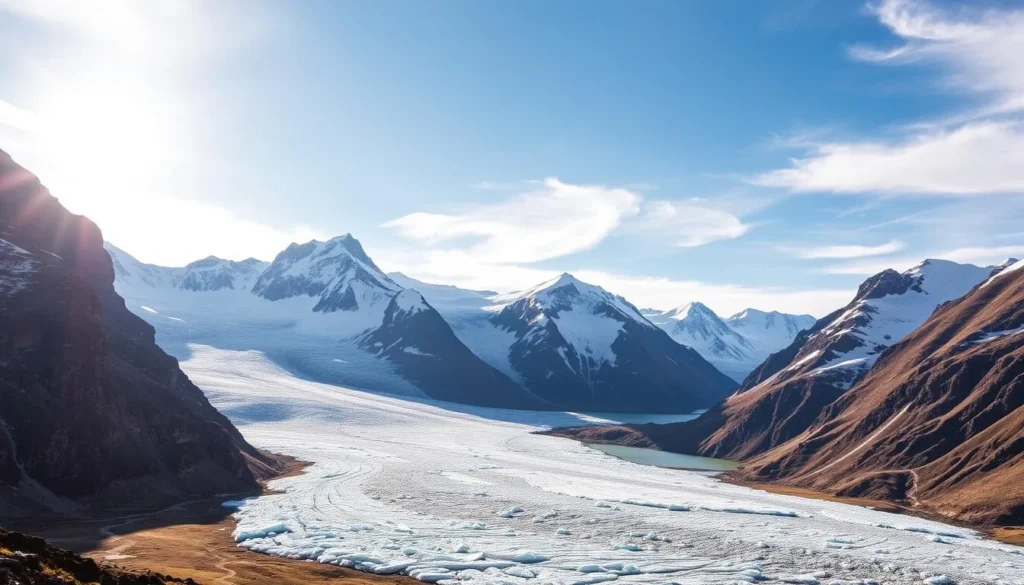
Glaciers and Alpine Features
The Corbassiere Glacier, one of the largest glaciers in the Alps, extends approximately 10km north from the Grand Combin massif. The glaciers in this region have significantly impacted the landscape, carving out valleys and leaving behind moraines. The contrast between the glaciers’ permanent snow and ice and the green Alpine meadows below creates a striking visual experience. However, it’s worth noting that these glaciers, like many others in the Alps, are retreating due to climate change.
- The Corbassiere Glacier is a notable feature of the Grand Combin landscape, attracting visitors from around the world.
- The glaciers have played a crucial role in shaping the region’s geography, creating valleys and depositing moraines.
- The visual contrast between the glaciers and the lower meadows is a unique aspect of the Grand Combin experience.
Best Time to Visit Grand Combin de Grafeneire
Planning your trip to Grand Combin de Grafeneire requires understanding the best time to visit. The mountain offers breathtaking views and exciting hiking opportunities, but its weather can be challenging.
Seasonal Considerations
The period from March to September is considered the best time to visit Grand Combin de Grafeneire. During these months, the weather conditions vary, offering different experiences. In the spring, the snow is still present, making it ideal for mountaineers. Summer brings warmer temperatures and longer days, perfect for hiking. You should be prepared for unpredictable weather, as conditions can change rapidly in the mountains.
- The weather in the Alps is notoriously changeable, with dramatic variations from valley to summit.
- Morning weather is typically more stable, making early ascents preferable.
- Clouds can create magical effects, sometimes filling valleys while peaks remain sunny.
Weather Patterns in the Alps
The Alps are known for their unpredictable weather patterns. When visiting Grand Combin de Grafeneire, be prepared for sudden changes. Dressing in layers is essential due to extreme temperature differences between sunny and shaded areas. Understanding these patterns will enhance your experience on the mountain.
| Season | Weather Conditions | Activities |
|---|---|---|
| Spring (March to May) | Unstable, snowy | Mountaineering |
| Summer (June to September) | Warmer, longer days | Hiking, trekking |
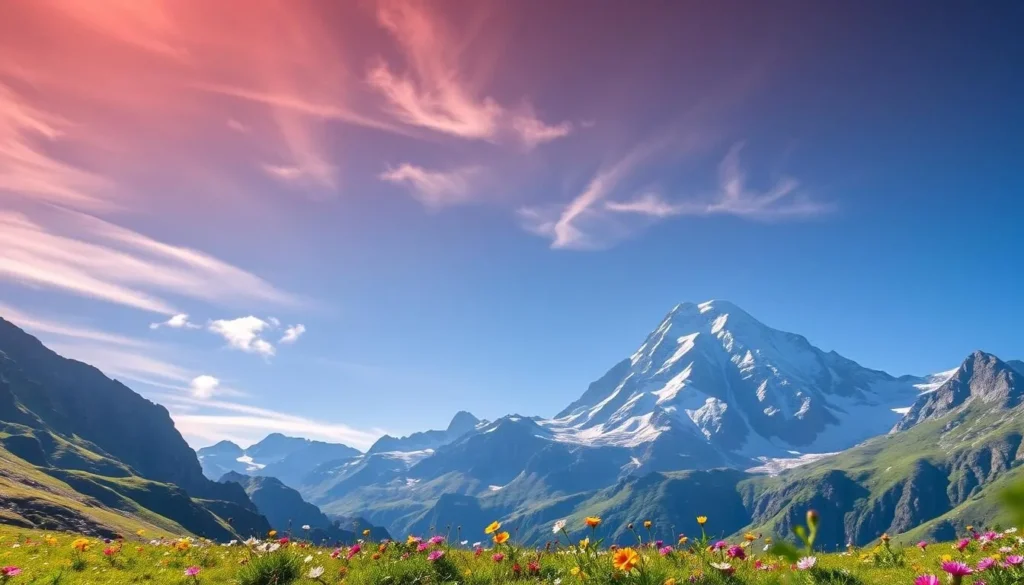
Tour des Combins: The Ultimate Hiking Experience
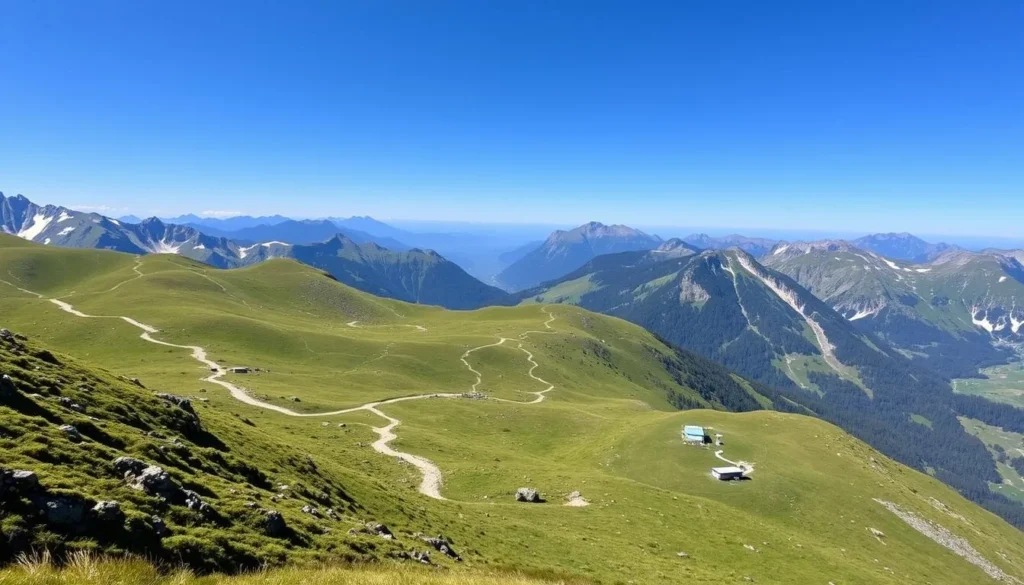
Discover the ultimate hiking experience in the Swiss Alps with the Tour des Combins, a trek that combines stunning landscapes with rich cultural heritage. This hiking tour is designed for those who seek adventure and breathtaking views, offering a journey through picturesque valleys and over majestic mountain passes.
Route Overview and Itinerary Options
The Tour des Combins starts at Bourg Saint-Pierre and can be completed in various stages, allowing hikers to tailor their itinerary according to their preferences. The traditional route proceeds counter-clockwise, passing through notable stops like Col de Mille, Panossière, Chanrion, and the Great St Bernard Pass, before returning to Bourg Saint-Pierre.
The flexibility of the tour is one of its key attractions, as hikers can choose to start from any point along the route. This flexibility makes it accessible to a wide range of travelers, from those looking for a leisurely day hike to seasoned trekkers aiming to complete the entire circuit.
Difficulty Level and Required Fitness
The Tour des Combins is considered a challenging hike due to its terrain and altitude. Hikers should be prepared for steep ascents and descents, as well as potentially unpredictable weather conditions. A good level of physical fitness is essential, along with appropriate hiking gear and experience with mountainous terrain.
Duration and Planning Your Trek
Typically, hikers take 6-7 days to complete the full Tour des Combins, although more experienced hikers can finish it in 4-5 days. It’s crucial to plan ahead, especially when it comes to booking mountain huts, which can fill up quickly during the peak season. Additionally, arranging transportation to and from the starting point, such as flying into Geneva, should be done in advance to ensure a smooth journey.
When planning your trek, consider the importance of booking accommodations early and the flexibility in the itinerary that allows you to adjust based on your preferences or unexpected changes in weather.
Day-by-Day Breakdown of Tour des Combins
As you undertake the Tour des Combins, you’ll experience the rich history and natural beauty of the Western Pennine Alps. This trek is a journey through some of the most breathtaking landscapes in the Alps, offering a unique blend of adventure and cultural heritage.
Bourg-Saint-Pierre to Cabane de Mille (Day 1)
The first day of your Tour des Combins journey begins in Bourg-Saint-Pierre, a charming village that serves as the gateway to the Grand Combin massif. You’ll hike to Cabane de Mille, a mountain hut that offers stunning views of the surrounding peaks and valleys.
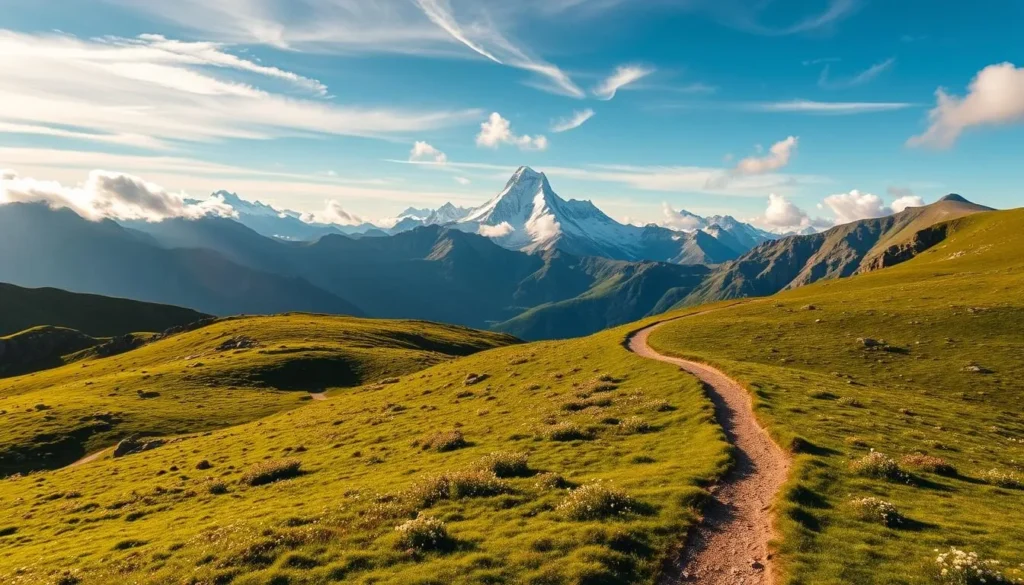
Cabane de Mille to Cabane de Panossière (Day 2)
On the second day, you’ll trek from Cabane de Mille to Cabane de Panossière, another picturesque mountain hut nestled in the heart of the Alps. This leg of the journey takes you through beautiful Alpine meadows and offers breathtaking views of the Grand Combin.
Panossière to Chanrion (Day 3)
Day three brings you from Cabane de Panossière to Chanrion, a historic site with a fascinating past. You’ll pass through the Pass de Chanrion, an area known for its unique geological features and stunning scenery.
Chanrion to Champillon (Day 4)
On day four, you’ll hike from Chanrion to Champillon, enjoying the picturesque landscapes and historical landmarks along the way. This section of the des Combins tour is known for its serene beauty and the opportunity to experience rural Alpine life.
Final Days and Return to Bourg-Saint-Pierre
The final days of your Tour des Combins take you through some of the route’s most historically significant sections, including the famous Great St. Bernard Pass. You’ll visit the historic Hospice du Grand-Saint-Bernard, a monastery that dates back to the 11th century and is famous for its rescue dogs and for sheltering Napoleon’s army in 1800. The final day’s hike returns you to the village of Bourg-Saint-Pierre via the Pas des Chevaux, an ancient mule path that offers one last taste of Alpine scenery. Completing the circuit brings a sense of accomplishment as you return to your starting point, having circumnavigated one of the Alps’ most impressive mountain massifs.
Throughout the Tour des Combins, you’ll be treated to breathtaking views, historical landmarks, and the unique culture of the Alpine regions. This trek is a must-do for anyone looking to experience the best of the Western Pennine Alps.
Grand Combin de Grafeneire, Switzerland: Best Things to Do – Top Picks
With its stunning landscapes and rich wildlife, the Grand Combin de Grafeneire region is a must-visit destination for nature lovers and adventure seekers alike. As you explore this beautiful area, you’ll find a wide range of exciting activities to enjoy.
Admiring the Corbassière Glacier
The Corbassière Glacier is one of the most striking features of the Grand Combin de Grafeneire region. This impressive glacier offers breathtaking views and is a must-see attraction for anyone visiting the area. You can admire the glacier’s beauty from various viewpoints, including the Corbassière suspension bridge.
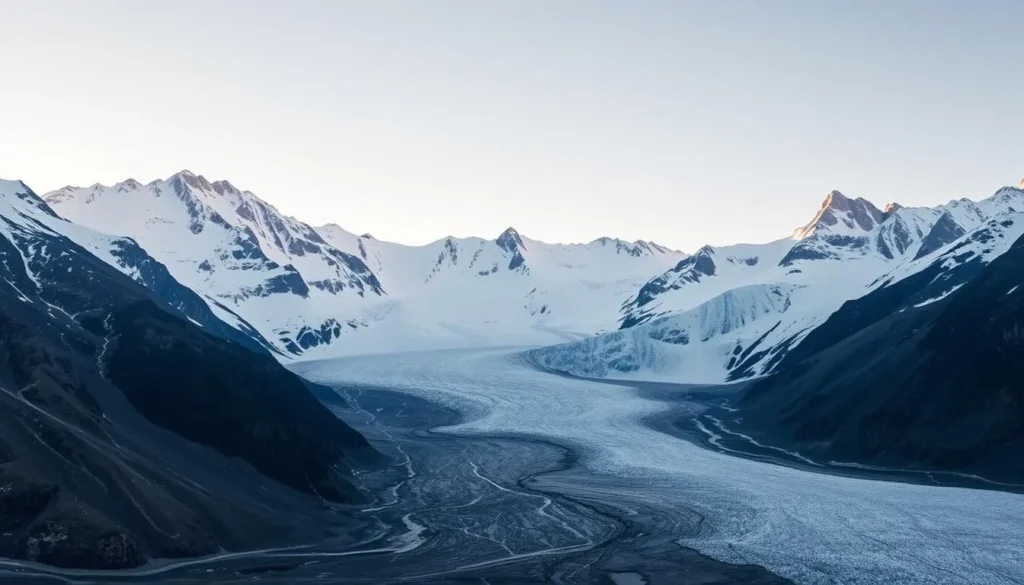
Visiting the Great St. Bernard Pass and Monastery
The Great St. Bernard Pass is a historic mountain pass that connects Switzerland to Italy. The pass is home to a beautiful monastery, which has been a refuge for travelers for centuries. You can visit the monastery and explore the surrounding area, taking in the stunning views of the surrounding mountains.
Wildlife Spotting: Ibexes and Alpine Fauna
The Grand Combin de Grafeneire region is home to a diverse range of wildlife, including ibexes, chamois, and marmots. As you hike through the trails, keep your eyes peeled for these amazing creatures, and be sure to bring your camera to capture the moment.
| Wildlife | Habitat | Best Time to Spot |
|---|---|---|
| Ibexes | Steep mountain slopes | Early morning |
| Chamois | Alpine meadows | Late afternoon |
| Marmots | Rocky outcrops | Mid-morning |
Photography Opportunities at Alpine Lakes and Summits
The Grand Combin de Grafeneire region offers endless photography opportunities, with dramatic summits, glaciers, and Alpine lakes creating perfect subjects in every direction. Be sure to bring your camera and take advantage of the golden hours of early morning and late afternoon to capture stunning images.
Some of the best viewpoints for photography include the Corbassière suspension bridge, Col des Otanes, and the panoramic terrace at Cabane de Panossière. The reflections of mountain peaks in Alpine lakes like those near the Great St. Bernard Pass provide classic Alpine photography opportunities.
As you hike the trails around Grand Combin, keep your camera accessible for unexpected wildlife encounters and changing light conditions that can create magical views in minutes. The contrast between snow-capped summits, blue glaciers, and green valleys offers spectacular compositional possibilities.
Mountain Huts and Accommodation Options
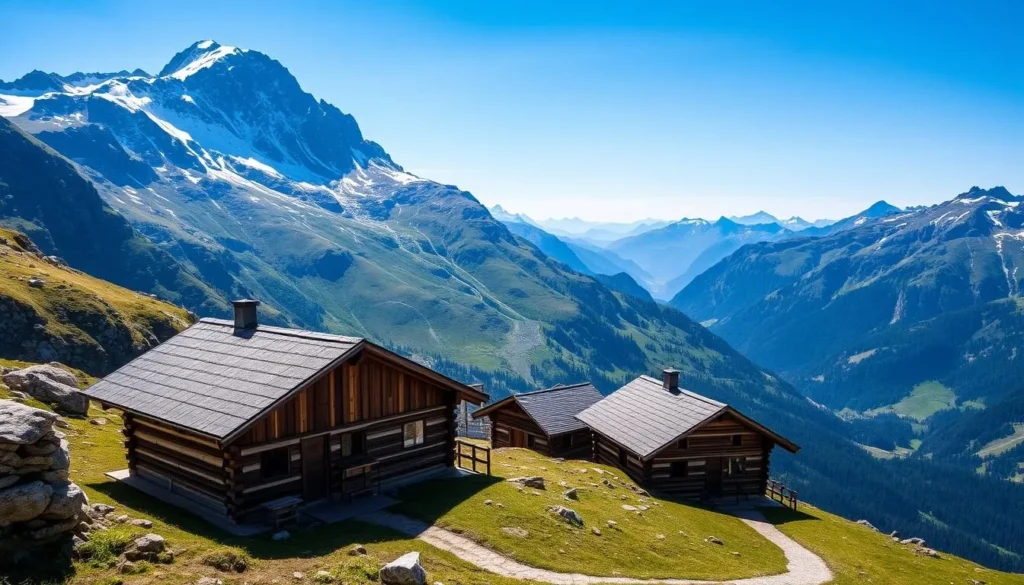
As you embark on the Tour des Combins, you’ll find that the mountain huts along the route offer more than just a place to rest. These huts are integral to the trekking experience, providing not only accommodation but also a chance to enjoy the local hospitality and cuisine.
Cabane de Panossière
Cabane de Panossière is one of the key mountain huts on the Tour des Combins route. It offers comfortable accommodation and stunning views of the surrounding mountains. The hut is well-maintained, providing a warm and welcoming atmosphere for trekkers.
Cabane de Chanrion
Cabane de Chanrion is another notable mountain hut on the Tour des Combins. Freshly renovated, it offers great comfort with small, comfortable dormitories and hot showers (for an extra charge). The couple managing the hut and their team are known for their hospitality, making it a standout stop on the tour.
Other Notable Mountain Refuges
You’ll find several other excellent mountain huts along the Tour des Combins route, each with its own unique character and spectacular setting. On the Swiss side, Cabane de Mille offers comfortable accommodation with a panoramic dining room overlooking the Val d’Entremont and Mont Blanc massif in the distance. When crossing into Italy’s Aosta Valley, you’ll stay at refuges like Rifugio Champillon, where you can enjoy authentic Italian cuisine and hospitality. The historic Hospice du Grand-Saint-Bernard provides a unique accommodation experience in a centuries-old monastery with a fascinating museum and cultural significance.
Most mountain huts along the route offer similar amenities: dormitory-style sleeping arrangements, half-board meal options, and basic washing facilities, though standards and prices vary slightly between locations.
Climbing Routes for Mountaineers
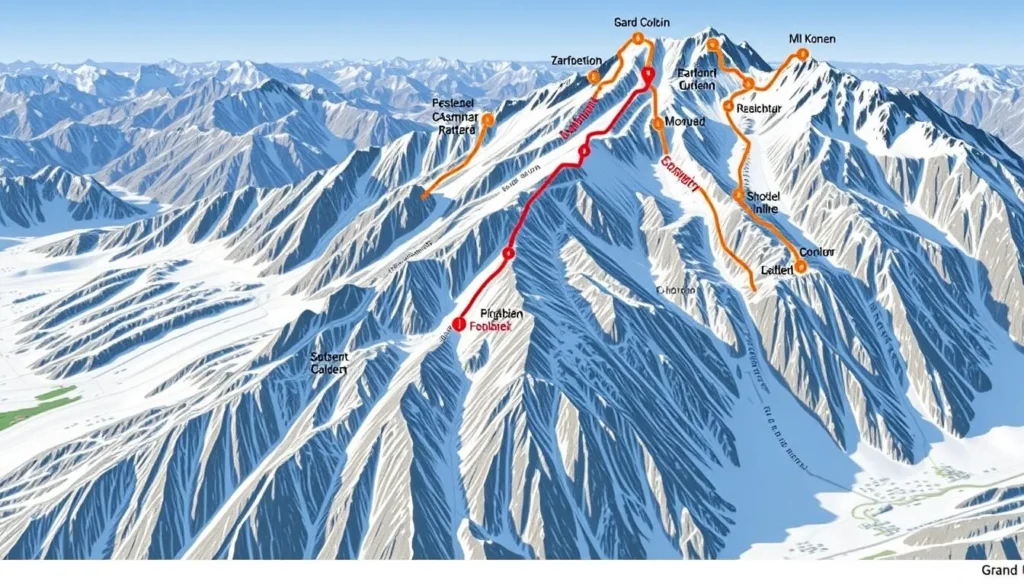
For experienced mountaineers, Grand Combin offers a thrilling challenge with its demanding climbing routes. The mountain requires a good level of fitness and endurance, as well as appropriate mountaineering equipment, especially during winter conditions.
The West Ridge of Combin de Valsorey
The West Ridge of Combin de Valsorey is a popular route that offers a challenging yet rewarding climb. This route demands technical skill and physical stamina. Climbers should be prepared for changing weather conditions and potential rockfall.
The North-West Face of Combin de Grafeneire
The North-West Face of Combin de Grafeneire presents a formidable climbing challenge. Climbers need to be well-versed in ice climbing techniques and have the necessary equipment to navigate this route safely. The way to the summit is demanding, with steep ice walls and potentially hazardous snow conditions.
Equipment and Safety Considerations
When attempting to climb Grand Combin, it’s crucial to have the right equipment and to follow safety guidelines. Climbers should be properly trained in glacier travel and crevasse rescue. Always check the current conditions before setting out, as the mountain’s course can change dramatically due to snowfall, melting, or rockfall. Consider hiring a certified mountain guide if you lack experience.
To ensure a safe and successful climb, remember to:
- Bring a complete set of mountaineering equipment, including crampons, ice axe, harness, helmet, and rope.
- Check current weather and snow conditions before heading out.
- Have good navigation skills to find your way on the mountain.
- Consider hiring a certified guide for enhanced safety and a successful summit.
Flora and Fauna of the Grand Combin Region
Hiking through the Grand Combin region, you’ll encounter a rich tapestry of Alpine flora and fauna. The area’s diverse ecosystems support a wide range of plant and animal life.
Alpine Flowers and Vegetation
The Grand Combin region is characterized by its lush Alpine meadows and diverse plant life. You’ll find a variety of Alpine flowers, including edelweiss and gentians, as you make your way through the trails. The region’s vegetation is adapted to the harsh Alpine climate, with hardy plants thriving in the challenging conditions.
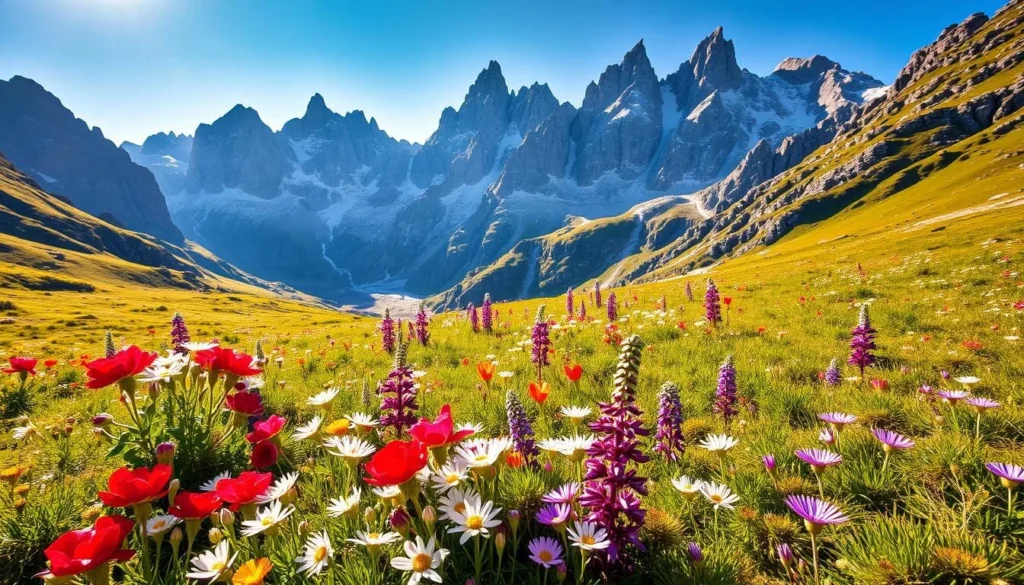
Wildlife Encounters on the Trail
As you hike on foot through the Grand Combin region, you’re likely to encounter various wildlife. Ibex are commonly spotted in the area, and you may catch a glimpse of them as they navigate the rugged terrain. Marmots are also prevalent, especially near Cabane Chanrion, where their distinctive whistles can be heard warning others of your approach. If you pass through a village or near mountain pastures, you may see traditional Hérens cattle, a unique breed found in the Valais region of Switzerland.
| Wildlife | Habitat | Best Viewing Times |
|---|---|---|
| Ibex | Rugged terrain, high altitudes | Early morning, late afternoon |
| Marmots | Near mountain huts, rocky areas | Throughout the day, especially near Cabane Chanrion |
| Hérens Cattle | Mountain pastures, near villages | During the day, when grazing |
Practical Information for Visitors
As you plan your trip to Grand Combin, it’s essential to have the right information to make the most of your adventure. The region offers a unique blend of natural beauty and exciting outdoor activities, including hiking on its numerous trails.
How to Get to Grand Combin
To reach Grand Combin, you can fly into Geneva Airport in Switzerland, which is the most convenient international airport serving the region. From Geneva, you can take a train or bus to Bourg-Saint-Pierre, a charming village that serves as a common starting point for many adventures in the Grand Combin area. If you’re coming from Italy, you can also access the region through the Aosta Valley.
Recommended Gear and Packing List
Packing the right gear is crucial for a successful and enjoyable trip to Grand Combin. Here’s a summary of the essentials:
| Item | Description |
|---|---|
| Hiking boots | Sturdy, waterproof boots for hiking and climbing |
| Clothing | Layers for varying weather conditions, including waterproof jacket and pants |
| Backpack | Comfortable backpack with rain cover for carrying essentials |
| Navigation tools | Map, compass, and GPS device or smartphone with GPS app |
| First aid kit | Basic first aid supplies, including bandages, antiseptic wipes, and pain relievers |
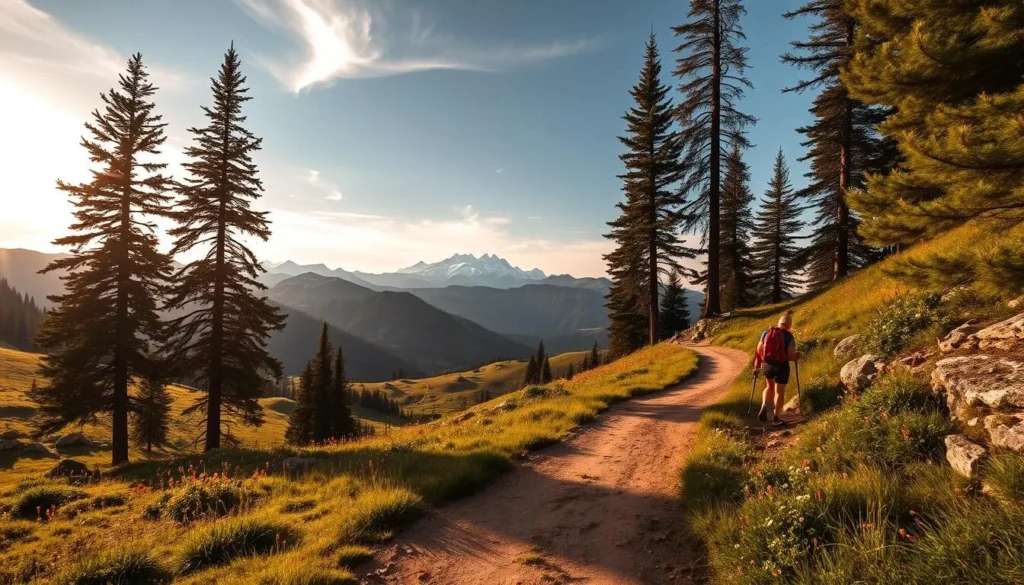
Permits and Regulations
While no special permits are required for hiking the trails around Grand Combin or completing the Tour des Combins, there are some regulations to be aware of. When crossing between Switzerland and Italy’s Aosta Valley, carry your passport or ID card, although border controls are minimal within the Schengen Area. Additionally, wild camping is generally prohibited, and overnight stays are limited to designated camping areas or mountain huts. Be sure to follow nature conservation regulations, including rules against picking protected plants, disturbing wildlife, or leaving trash on the trails.
By being mindful of these practical considerations, you can have a safe and enjoyable experience exploring the beautiful region around Grand Combin.
Tour des Combins vs. Tour du Mont Blanc
When considering a hiking tour in the Alps, two prominent options are the Tour des Combins and the Tour du Mont Blanc. Both offer unique experiences, but they differ in several key aspects.
Crowds and Experience
The Tour des Combins is often described as less crowded than the Tour du Mont Blanc, providing a more serene hiking experience. As Eloi notes, “It’s higher and more Alpine, and you get high-quality but simple hospitality.” This suggests that while both tours offer exceptional scenery, the Tour des Combins may provide a more intimate connection with nature.
Difficulty and Accessibility Differences
The Tour des Combins is generally considered more challenging due to its higher average elevations and fewer amenities along the route. Key differences include:
- Higher passes, such as the Col des Otanes at 2,870m, making it more physically demanding.
- Fewer public transportation connections, making the Tour des Combins more remote.
- The tour crosses between Switzerland and Italy’s Aosta Valley, adding cultural dimensions.
Both tours are well-marked, but the Tour des Combins requires more self-sufficiency.
Conclusion
With its towering peaks and serene valleys, Grand Combin de Grafeneire is a destination that embodies the essence of Alpine beauty. The Grand Combin massif offers a haven for hiking and climbing enthusiasts, with trails that reward adventurers with breathtaking mountain views. By visiting this magnificent region, you’re experiencing a balance of tourism and preservation, ensuring an authentic Alpine experience.
As you plan your trip, remember that the journey is part of the adventure. Whether you’re tackling the multi-day Tour des Combins or enjoying day hikes, Grand Combin Grafeneire promises an unforgettable experience in the Swiss Alps.
The above is subject to change.
Check back often to TRAVEL.COM for the latest travel tips and deals.
